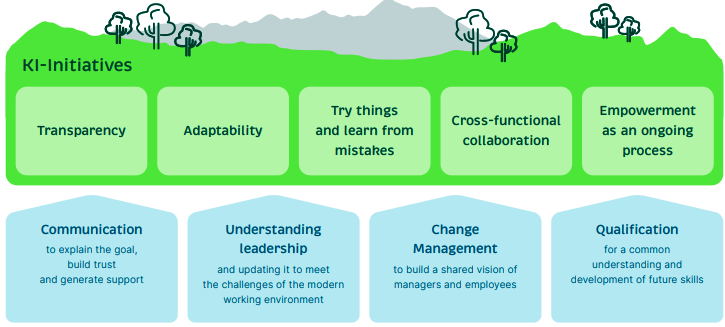The integration of artificial intelligence (AI) is increasingly becoming a crucial competitive factor in day-to-day business. Microsoft Copilot, an example of the use of AI, offers users the ability to make their everyday work with M365 applications easier – with a positive impact on personal productivity, creativity, and work quality. But introducing AI is more than just implementing software. It requires a deeper look at collaboration within the company, and thus also at the values that guide leadership within the organization and the corporate culture.
In our projects, we see that organizations can reach their AI objectives faster and more effectively if they embrace certain cultural values before and during the integration process itself. We’ve summarized our findings for you.

Transparency
Companies are bringing AI online with two key uncertainties. First, most employees are unfamiliar with how it will affect their work, and second, there is little experience working with the most common tools. As a result, there are mixed feelings about AI, with uncertainty and preconceived notions on one side, and curiosity and high expectations for productivity on the other.
Transparent communication can help overcome this uncertainty. Making the benefits of the new technology clear to potential users helps foster trust and acceptance – along with willingness to engage with AI. The internal communications team, managers, and employees alike are called upon to share background information and experiences: internal communications in the form of concrete examples of application, and managers and employees as ambassadors and early adopters in personal dialogue with each other.
Customer example: transparent communication
Our customer has set up a separate section of the intranet for those interested in AI, featuring FAQs, guidelines on trying AI, and various dialogue formats. There are even plans for an AI movie night.
Adaptability
Our experience shows that the more flexible a company’s structure is, the faster that company is in incorporating new technologies and putting them to work. Organizations that combine flexibility and customer centricity tend to pool resources where they create the most value. This means flexible companies are also faster to build efficiency, for example in the use of AI-trained chatbots for support or in using AI as part of their customer data platform.
In a flexible organization, AI is helps in two waysƒ: First, it can be used to analyze data from various sources and highlight where it currently delivers the most value. Second, it can then be used to provide support for highly repetitive operational activities, freeing up resources for strategic project work.
The trial and error approach
Develop, test, obtain feedback, iterate – if this cycle is a firmly embedded part of a company’s culture, it is easier for employees to meet requirements and to target them more effectively. This means a culture of learning is a crucial element of success in implementing AI. With this kind of culture in place, we can quickly move the pilot phase into trying things out, gaining experience, and reflection with the target groups selected by the customer.
One key insight here is that it is okay if results are not immediately apparent for every single new use case. Trying things out and learning from mistakes helps to build practical knowledge and experience, which is so important when working with AI. This knowledge, supported by measures such as enablement workshops, “lunch and learn” sessions, and supplementary communications, can help employees better navigate their way to a productive solution.
Customer example: persona workshops
Some of our pilot phases start by meeting with clients and end users of AI solutions to define personas. This helps both the customer and us to understand which target groups make sense for application of AI solutions within the organization – and which do not.
Cross-functional collaboration
Anyone who has ever participated in the “Six Thinking Hats” exercise knows how valuable it can be to adopt multiple perspectives. However, in an organization with division of labor, collaboration is often restricted to just a single role or function. In our experience, organizations that have employees look at customer issues from diverse roles and backgrounds are significantly more effective at integrating AI.
Considering challenges from different perspectives – across hierarchies and functional separations – enables informed dialogue that cuts across the various technical, business, and cultural functionalities with all their advantages or disadvantages. It is important to engage in this kind of dialogue when implementing AI solutions, as it is elsewhere. For example, it is necessary to weigh the economic benefits of a solution (such as efficiency gains) against the potential drawbacks (such as data leakage). With their diverse experience, cross-functional teams are best positioned to make these determinations.
Enablement as an ongoing process
Strategic personnel development is a cultural factor. Continuous learning enables organizations and their employees to adapt. By analyzing trends, the personnel development team can identify the capabilities that will be needed in the future and adjust the portfolio of training activities accordingly, adding new trainings and expanding existing ones. An attractive range of training options is also one way HR contributes in the war for talent. Continuing education long ago became a factor in choosing an employer.
Again, our experience shows that organizations that embrace learning and continuous growth through the acquisition of strategic skills will find it easier to adopt AI. Collective training activities, peer-to-peer learning, and/or communities of practice help foster individual skill building while also opening up room for dialogue about AI and how it is used – thereby bringing the corporate culture to life.
Conclusion
In the future, our day-to-day work will increasingly be shaped by advances in technology and interaction between humans and machines. This article discusses the values relating to collaboration and organizational culture that we believe contribute to the integration of new technologies. Transparency, adaptability, openness to mistakes, cross-functional collaboration, and continuous skill building are the key factors we have identified as characterizing organizations with a high level of maturity in adopting AI.


